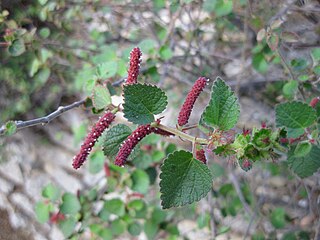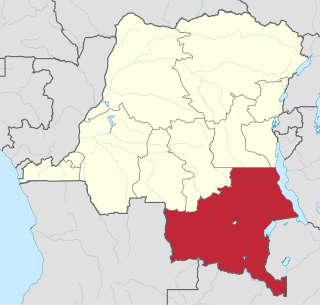
The ringed seal is an earless seal inhabiting the Arctic and sub-Arctic regions. The ringed seal is a relatively small seal, rarely greater than 1.5 m in length, with a distinctive patterning of dark spots surrounded by light gray rings, hence its common name. It is the most abundant and wide-ranging ice seal in the Northern Hemisphere, ranging throughout the Arctic Ocean, into the Bering Sea and Okhotsk Sea as far south as the northern coast of Japan in the Pacific and throughout the North Atlantic coasts of Greenland and Scandinavia as far south as Newfoundland, and including two freshwater subspecies in northern Europe. Ringed seals are one of the primary prey of polar bears and killer whales, and have long been a component of the diet of indigenous people of the Arctic.
Foxtail or fox tail may refer to:

Acalypha is a genus of flowering plants in the family Euphorbiaceae. It is the sole genus of the subtribe Acalyphinae. It is one of the largest euphorb genera, with approximately 450 to 462 species. The genus name Acalypha is from the Ancient Greek ἀκαλύφη (akalúphē) ("nettle"), an alternative form of ἀκαλήφη (akalḗphē), and was inspired by the nettle-like leaves. General common names include copperleaf and three-seeded mercury. Native North American species are generally inconspicuous most of the year until the fall when their stems and foliage turn a distinctive coppery-red.

Tragia is a genus of flowering plants in the spurge family, Euphorbiaceae. It is widespread across North and South America, Africa, the Arabian Peninsula, the Indian Subcontinent, northern Australia, and to various islands in the Caribbean and in the Indian Ocean.

The Kingwood Center Gardens is a historic 47-acre (190,000 m2) site with a house, Kingwood Hall, gardens and greenhouses located in Mansfield, Ohio.

Nepenthes hispida is a tropical pitcher plant species native to Borneo. It grows at elevations of 100 to 800 m in kerangas forest. It is known with certainty only from Lambir Hills National Park and surrounding areas.
Cat tails, cattail, or cat's tails are common names for several plants and may refer to:

Atheris hispida is a viper species endemic to Central Africa. Like all other vipers, it is venomous. It is known for its extremely keeled dorsal scales that give it a bristly appearance. No subspecies are currently recognized. Common names include rough-scaled bush viper, spiny bush viper, hairy bush viper, and others.

Acalypha hispida, the chenille plant, is a flowering shrub which belongs to the family Euphorbiaceae, the subfamily Acalyphinae, and the genus Acalypha. Acalypha is the fourth largest genus of the family Euphorbiaceae, and contains many plants native to Oceania.

Acalypha rubrinervis is an extinct plant in the spurge family (Euphorbiaceae), from the island of Saint Helena in the South Atlantic Ocean. It was called string tree on account of the thin pendulous inflorescences which resembled red strings. Disturbance following human settlement on the island destroyed its habitat and it was last seen in the 19th century. It is thus one of a number of island plants to have been driven to extinction by human activity.

The flowering shrub Acalypha californica is known as the California copperleaf, and sometimes by the older name Pringle three-seeded mercury. It is the only Acalypha species native to California, where it is most abundant in the hills of San Diego County. It is a member of the chaparral plant community.

The Andaman spiny shrew or Andaman shrew is a species of mammal in the family Soricidae. It is endemic to India. Its natural habitat is subtropical or tropical dry forests.
Acalypha hontauyuensis is a species of plant in the family Euphorbiaceae. It is a shrub endemic to Orchid Island, Taiwan. The Flora of China, however, lists it as a synonym of Acalypha suirenbiensis from the Taiwanese mainland.
Mota is an Oceanic language spoken by about 750 people on Mota island, in the Banks Islands of Vanuatu. It is the most conservative Torres–Banks language, and the only one to keep its inherited five-vowel system intact while also preserving most final vowels.

Acalypha indica is an herbaceous annual that has catkin-like inflorescences with cup-shaped involucres surrounding the minute flowers. It is mainly known for its root being attractive to domestic cats, and for its various medicinal uses. It occurs throughout the Tropics.

Acalypha wilkesiana, common names copperleaf, Jacob's coat and Flamengueira, is an evergreen shrub growing to 3 metres (9.8 ft) high and 2 metres across. It has a closely arranged crown, with an erect stem and many branches. Both the branches and the leaves are covered in fine hairs. The leaves, which may be flat or crinkled, are large and broad with teeth around the edge. They can be 10–20 centimetres (3.9–7.9 in) long and 15 centimetres (5.9 in) wide. The leaves are coppery green with red splashes, giving them a mottled appearance. Separate male and female flowers appear on the same plant. The male flowers are in long spikes which hang downwards while the female flowers are in short spikes. The latter do not show up easily as they are often hidden among the leaves. The flower stalks are 10–20 cm long.

Acalypha dikuluwensis was a 25 centimetres (9.8 in) high tropical flowering plant in the genus Acalypha of the family Euphorbiaceae. The IUCN Red List of Threatened Species declared the plant extinct in 2012. A. dikuluwensis was endemic to copper-rich soils of eastern Katanga Province of the Democratic Republic of the Congo, and was only found around Dikuluwe. The soils are derived from Katanga Supergroup Upper Cambrian Roan Group rocks. It was restricted to steppic savanna in copper outcrops, which were destroyed by surface mining. No specimens were found after 1959.

Acalypha chamaedrifolia, the red cat's tail, is a species of flowering plant in the family Euphorbiaceae, native to southern Florida and the islands of the Caribbean. It performs best in a loam-less potting mixture. As its synonym Acalypha hispaniolae it gained the Royal Horticultural Society's Award of Garden Merit in 2002, but this seems to have been rescinded.













